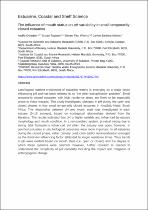 ResearchSpace
ResearchSpace
The influence of mouth status on pH variability in small temporarily closed estuaries
JavaScript is disabled for your browser. Some features of this site may not work without it.
- ResearchSpace
- →
- Research Publications/Outputs
- →
- Journal Articles
- →
- View Item
| dc.contributor.author |
Omarjee, Aadila

|
|
| dc.contributor.author |
Taljaard, Susan

|
|
| dc.contributor.author |
Weerts, Steven P

|
|
| dc.contributor.author |
Adams, JB

|
|
| dc.date.accessioned | 2020-10-27T12:28:22Z | |
| dc.date.available | 2020-10-27T12:28:22Z | |
| dc.date.issued | 2020-11 | |
| dc.identifier.citation | Omarjee, A., Taljaard, S., Weerts, S.P. & Adams, J.B. 2020. The influence of mouth status on pH variability in small temporarily closed estuaries. Estuarine, Coastal and Shelf Science, vol 246. pp. 1-6 | en_US |
| dc.identifier.issn | 0272-7714 | |
| dc.identifier.issn | 1096-0015 | |
| dc.identifier.uri | https://doi.org/10.1016/j.ecss.2020.107043 | |
| dc.identifier.uri | https://www.sciencedirect.com/science/article/pii/S0272771420307745 | |
| dc.identifier.uri | http://hdl.handle.net/10204/11639 | |
| dc.description | Copyright: 2020, Elsevier. Due to copyright restrictions, the attached PDF file contains the abstract of the full-text item. For access to the full-text item, please consult the publisher's website. | en_US |
| dc.description.abstract | Land-based nutrient enrichment of estuarine waters is emerging as a major factor influencing pH and has been referred to as “the other eutrophication problem”. Small temporarily closed estuaries with high residence times are likely to be especially prone to these impacts. This study investigated changes in pH during the open and closed phases in four small temporarily closed estuaries in KwaZulu-Natal, South Africa. The relationship between pH and mouth state was investigated in each estuary (6–16 surveys), based on conceptual relationships derived from the literature. The results indicated that pH is highly variable and influenced by estuary morphology and mouth condition. In a non-perched system, physical mixing due to strong tidal fluctuations influenced pH when the estuary was open; however, in perched estuaries in situ biological processes were more important. In all estuaries during the closed phase, either primary production and/or remineralisation emerged as the dominant influencing factor attributed to longer residence times. Thus trends in pH were evident based on mouth state (i.e. open or closed) and the degree to which these systems were perched, however, further research is needed to understand the complexity of pH variability including the impact and mitigation of anthropogenic change. | en_US |
| dc.language.iso | en | en_US |
| dc.publisher | Elsevier | en_US |
| dc.relation.ispartofseries | Workflow;23855 | |
| dc.subject | Biogeochemistry | en_US |
| dc.subject | Mouth state | en_US |
| dc.subject | Mixing | en_US |
| dc.subject | Primary production | en_US |
| dc.subject | Remineralisation | en_US |
| dc.subject | Residence time | en_US |
| dc.title | The influence of mouth status on pH variability in small temporarily closed estuaries | en_US |
| dc.type | Article | en_US |
| dc.identifier.apacitation | Omarjee, A., Taljaard, S., Weerts, S. P., & Adams, J. (2020). The influence of mouth status on pH variability in small temporarily closed estuaries. http://hdl.handle.net/10204/11639 | en_ZA |
| dc.identifier.chicagocitation | Omarjee, Aadila, Susan Taljaard, Steven P Weerts, and JB Adams "The influence of mouth status on pH variability in small temporarily closed estuaries." (2020) http://hdl.handle.net/10204/11639 | en_ZA |
| dc.identifier.vancouvercitation | Omarjee A, Taljaard S, Weerts SP, Adams J. The influence of mouth status on pH variability in small temporarily closed estuaries. 2020; http://hdl.handle.net/10204/11639. | en_ZA |
| dc.identifier.ris | TY - Article AU - Omarjee, Aadila AU - Taljaard, Susan AU - Weerts, Steven P AU - Adams, JB AB - Land-based nutrient enrichment of estuarine waters is emerging as a major factor influencing pH and has been referred to as “the other eutrophication problem”. Small temporarily closed estuaries with high residence times are likely to be especially prone to these impacts. This study investigated changes in pH during the open and closed phases in four small temporarily closed estuaries in KwaZulu-Natal, South Africa. The relationship between pH and mouth state was investigated in each estuary (6–16 surveys), based on conceptual relationships derived from the literature. The results indicated that pH is highly variable and influenced by estuary morphology and mouth condition. In a non-perched system, physical mixing due to strong tidal fluctuations influenced pH when the estuary was open; however, in perched estuaries in situ biological processes were more important. In all estuaries during the closed phase, either primary production and/or remineralisation emerged as the dominant influencing factor attributed to longer residence times. Thus trends in pH were evident based on mouth state (i.e. open or closed) and the degree to which these systems were perched, however, further research is needed to understand the complexity of pH variability including the impact and mitigation of anthropogenic change. DA - 2020-11 DB - ResearchSpace DP - CSIR KW - Biogeochemistry KW - Mouth state KW - Mixing KW - Primary production KW - Remineralisation KW - Residence time LK - https://researchspace.csir.co.za PY - 2020 SM - 0272-7714 SM - 1096-0015 T1 - The influence of mouth status on pH variability in small temporarily closed estuaries TI - The influence of mouth status on pH variability in small temporarily closed estuaries UR - http://hdl.handle.net/10204/11639 ER - | en_ZA |





